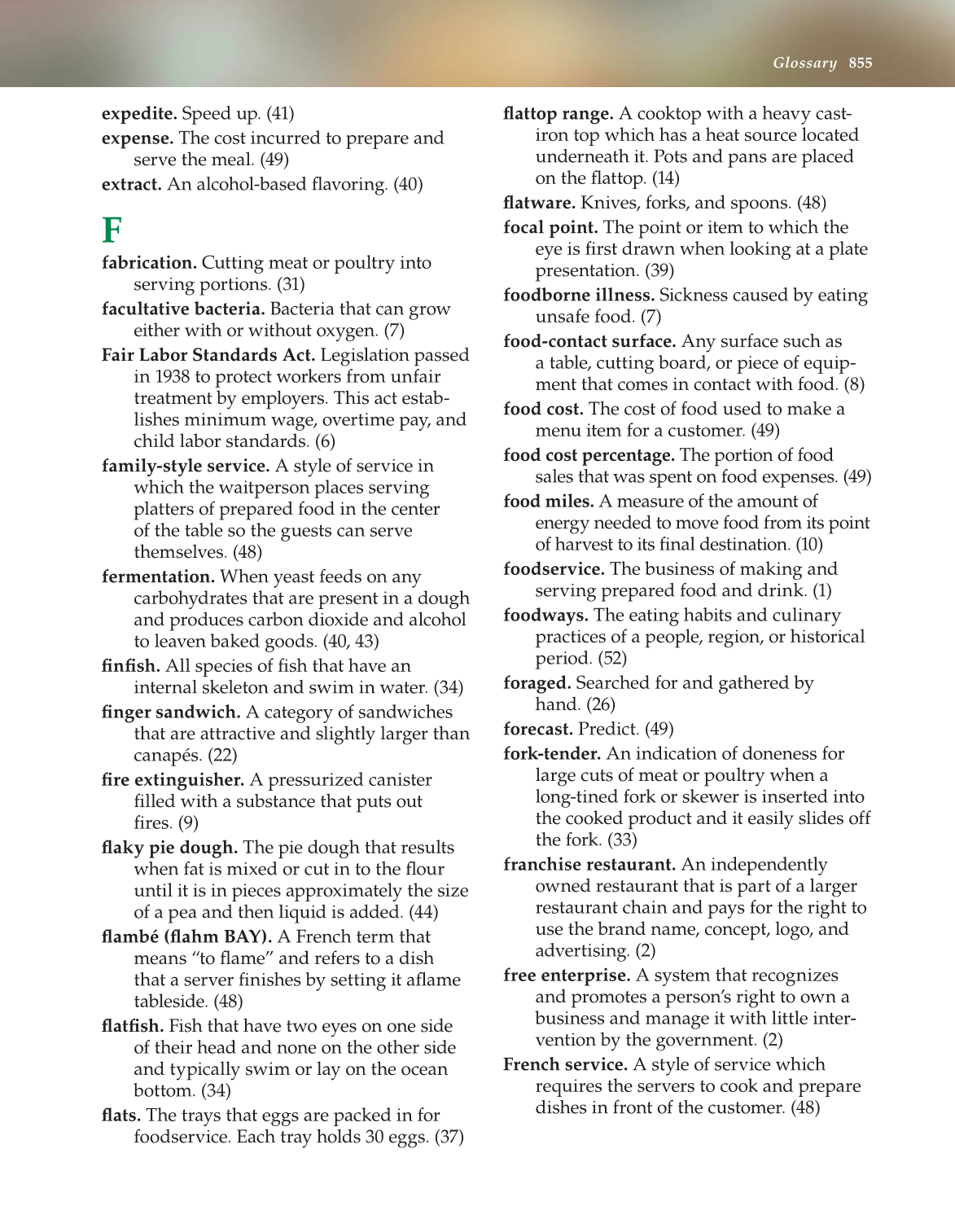Glossary 855
expedite. Speed up. (41)
expense. The cost incurred to prepare and
serve the meal. (49)
extract. An alcohol-based fl avoring. (40)
F
fabrication. Cutting meat or poultry into
serving portions. (31)
facultative bacteria. Bacteria that can grow
either with or without oxygen. (7)
Fair Labor Standards Act. Legislation passed
in 1938 to protect workers from unfair
treatment by employers. This act estab-
lishes minimum wage, overtime pay, and
child labor standards. (6)
family-style service. A style of service in
which the waitperson places serving
platters of prepared food in the center
of the table so the guests can serve
themselves. (48)
fermentation. When yeast feeds on any
carbohydrates that are present in a dough
and produces carbon dioxide and alcohol
to leaven baked goods. (40, 43)
fi nfi sh. All species of fi sh that have an
internal skeleton and swim in water. (34)
fi nger sandwich. A category of sandwiches
that are attractive and slightly larger than
canapés. (22)
fi re extinguisher. A pressurized canister
fi lled with a substance that puts out
fi res. (9)
fl aky pie dough. The pie dough that results
when fat is mixed or cut in to the fl our
until it is in pieces approximately the size
of a pea and then liquid is added. (44)
fl ambé (fl ahm BAY). A French term that
means “to fl ame” and refers to a dish
that a server fi nishes by setting it afl ame
tableside. (48)
fl atfi sh. Fish that have two eyes on one side
of their head and none on the other side
and typically swim or lay on the ocean
bottom. (34)
fl ats. The trays that eggs are packed in for
foodservice. Each tray holds 30 eggs. (37)
fl attop range. A cooktop with a heavy cast-
iron top which has a heat source located
underneath it. Pots and pans are placed
on the fl attop. (14)
fl atware. Knives, forks, and spoons. (48)
focal point. The point or item to which the
eye is fi rst drawn when looking at a plate
presentation. (39)
foodborne illness. Sickness caused by eating
unsafe food. (7)
food-contact surface. Any surface such as
a table, cutting board, or piece of equip-
ment that comes in contact with food. (8)
food cost. The cost of food used to make a
menu item for a customer. (49)
food cost percentage. The portion of food
sales that was spent on food expenses. (49)
food miles. A measure of the amount of
energy needed to move food from its point
of harvest to its fi nal destination. (10)
foodservice. The business of making and
serving prepared food and drink. (1)
foodways. The eating habits and culinary
practices of a people, region, or historical
period. (52)
foraged. Searched for and gathered by
hand. (26)
forecast. Predict. (49)
fork-tender. An indication of doneness for
large cuts of meat or poultry when a
long-tined fork or skewer is inserted into
the cooked product and it easily slides off
the fork. (33)
franchise restaurant. An independently
owned restaurant that is part of a larger
restaurant chain and pays for the right to
use the brand name, concept, logo, and
advertising. (2)
free enterprise. A system that recognizes
and promotes a person’s right to own a
business and manage it with little inter-
vention by the government. (2)
French service. A style of service which
requires the servers to cook and prepare
dishes in front of the customer. (48)
